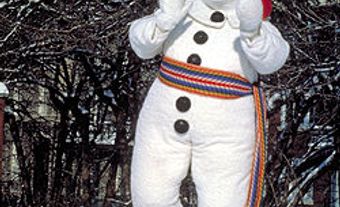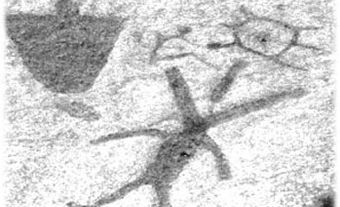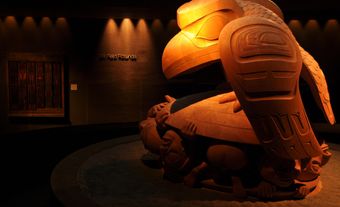Inuit Traditional Stories are a repository of Inuit culture, passed down by Elders through generations to enrich and enlighten. Traditionally used in all aspects of daily life, Inuit Traditional Stories have undergone a resurgence in popularity as community groups aim to preserve traditional teachings as a method of cultural and political solidarity.

Traditional Stories
Traditional Stories are usually seen as narratives used to explain characters, experiences or phenomena of religious or spiritual importance that are illustrative of a certain community’s belief system. They are also stories handed down by tradition based on history.
The Inuit People
Inuit, who make their homes across the vastness of the Arctic, belong to a much larger family that extends from the Bering Sea through Alaska and northern Canada to Greenland. Inuit are linked not only linguistically, but by a distinctly similar culture and way of life, as seen through Inuit art, song, dance and Traditional Stories.
Inuit Traditional Stories
Like all Traditional Stories, Inuit Traditional Stories are both entertaining and instructive. The Inuit designated the powers of good and evil to deities living in a spirit world closely entwined with the starkly beautiful northern landscape.
Inuit Oral Traditions were employed as the most important method of conveying and preserving ideas, augmented sometimes by small carvings that may have served as illustrations for events. Songs and dances also enhanced the meanings of Traditional Stories, which upheld the existing system, bolstered the cultural practices of Inuit society, and verbalized a sense of right and wrong. These early tales were intrinsically linked to Inuit shamanism.
Inuit Traditional Stories are usually short dramatic forms dealing with the wonders of the world: the creation, the heavens, birth, love, hunting and sharing food, respect for Elders, polygamy, murder, infanticide, incest, death and the mystery of afterlife. Inuit storytellers continue to remodel and create new Traditional Stories.
Inuit Traditional Stories are rarely simple, usually abounding with behavioural codes that may only be fully understood by those living within that society. The stories reinforce a close relationship with all of nature, as well as the belief that animals have the magical power to hear and understand human words. For this reason, hunters in their camps, when singing or speaking of walrus or seal, may carefully refer to them as maggots or lice, or call caribou lemmings, thus confusing the animals that are necessary for their survival.
Traditional Stories and Beings
A fundamental tenet of Inuit Traditional Stories is the belief in other worlds beneath the sea, inside the Earth and in the sky where some gifted angakoks (shamans) have the power to journey in trances and in dreams, visiting places that ordinary mortals would only experience in the afterlife.
Dreams have always played an important part in the lives of Inuit, perhaps serving as the basis for some Traditional Stories. Dreams are interpreted with care. Dreams of polar bears are said to have sexual overtones. Dreams of weasels suggest troubles. Bird dreams forewarn of blizzards.
Some Inuit Traditional Stories are thought-provoking in their deceptive simplicity. An extremely short example is as follows: Onto a boy's arm came a mosquito. "Don't hit! Don't hit!" it hummed. "Grandchildren have I to sing to." "Imagine," the boy said,"So small and yet a grandfather."
Nunavut Animation Lab: Lumaajuuq by Alethea Arnaquq-Baril, National Film Board of Canada
Among the most famous Inuit Traditional Stories is the story of the sea goddess, known by various names (Sedna, Nuliayuk, Taluliyuk, Taleelayuk). In the story, a young girl is cast into the ocean, where she becomes the keeper of all the sea mammals.
The story of Lumiuk (Lumak, Lumaag) tells of an abused blind boy who finds refuge in the sea, where he recovers his sight and ends his abuse. The story of Kiviuk (Kiviok, Kiviuq), a major figure in the same sphere as Sedna, explains the abundance of fish and the absence of trees in the Arctic tundra; while the story of Tikta’Liktak tells of a young hunter’s journey home after becoming lost on an ice floe.
Supernatural beings accompany many Inuit Traditional Stories, including: Mahaha, a demon that terrorizes the Arctic and tickles its victims to death; Ijiraat, shapeshifters that may change into any Arctic animal but may not disguise their red eyes; Taqriaqsuit, shadow people who are rarely seen but often heard; Qallupilluk (or Qalupalik, see below), scaly, human-like creatures that snatch children into the sea; Inupasugjuk, giants who capture humans; and Tuniit, who are seen as simple-minded but extremely strong ancestors of the Inuit.
Nunavut Animation Lab: Qalupalik by Ame Papatsie, National Film Board of Canada
Preservation
Oral Culture represents a valuable intellectual possession that, once lost, has no way of returning. Thus, many programs exist to promote the use and understanding of Inuit Traditional Stories. One such program was developed by the Qikiqtani Inuit Association and encourages readers to speak with Elders in the community to learn more, and to pass the stories on themselves, thus reinforcing the importance of listening and storytelling to the survival of Oral Culture.

 Share on Facebook
Share on Facebook Share on X
Share on X Share by Email
Share by Email Share on Google Classroom
Share on Google Classroom


